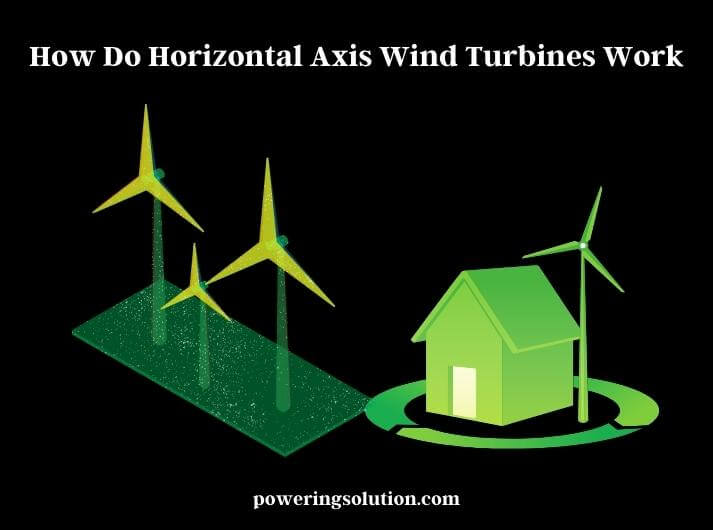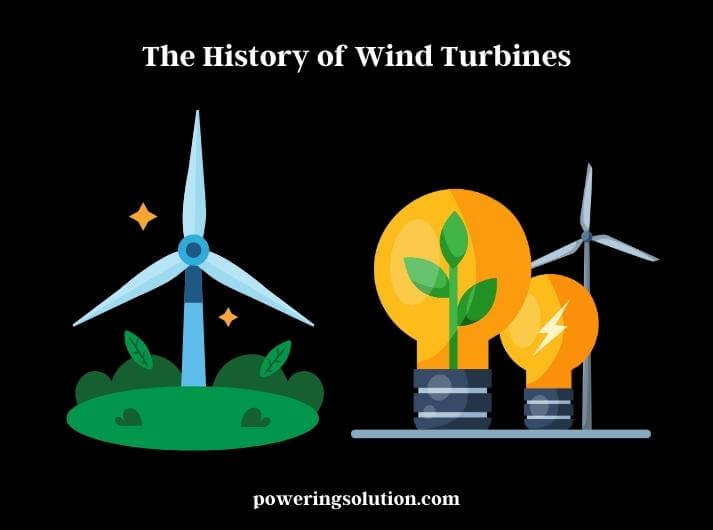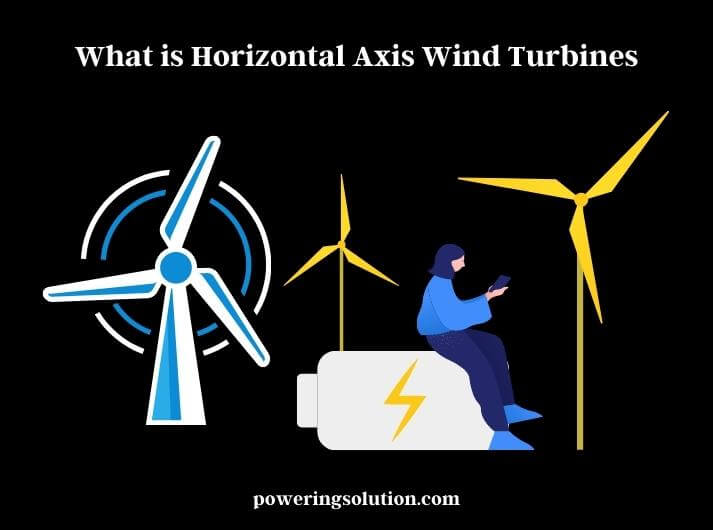As the world continues to grapple with the devastating effects of climate change, renewable energy sources such as wind turbines have become increasingly important. Among the various types of wind turbines, horizontal axis wind turbines (HAWTs) are the most commonly used for generating electricity. HAWTs are found in a variety of settings, from large wind farms to smaller residential units.

With the rising demand for clean, renewable energy, it is crucial to understand how HAWTs work and their role in combating climate change. We will delve into the science behind HAWTs and explore the components that make up a wind turbine. We will also look at the benefits of using HAWTs as a sustainable energy source and address some frequently asked questions.
The History of Wind Turbines
Wind turbines have been used for centuries to harness the power of wind and convert it into mechanical energy. The earliest recorded use of wind power dates back to ancient Persia, where windmills were used to grind grains and pump water. Over time, windmills spread throughout the world and were used for various applications, including sawing wood, grinding flour, and pumping water.
The modern wind turbine, however, was not developed until the late 19th century. In 1888, Charles F. Brush designed and built the first wind turbine to generate electricity in Cleveland, Ohio. The turbine had a rotor diameter of 17 meters and produced around 12 kilowatts of electricity.

During the early 20th century, wind turbines were used primarily for generating electricity in remote areas where other sources of power were not available. In the 1920s and 1930s, wind turbines became more widespread in the United States, particularly in the Midwest, where they were used to pump water for irrigation and to generate electricity for rural communities.
The first large-scale wind farm was built in California in the 1980s. The farm, located in Altamont Pass, consisted of around 5000 small wind turbines and had a total capacity of 5 megawatts. Since then, wind energy has continued to grow in popularity and has become a major source of renewable energy around the world.
Today, wind turbines are found in many countries and are used to generate electricity on both small and large scales. They are particularly prevalent in Europe, where countries such as Denmark, Germany, and Spain have invested heavily in wind energy. In the United States, wind energy has also seen significant growth, with Texas leading the way in wind energy production.
As technology continues to improve, wind turbines are becoming more efficient and cost-effective. Advances in materials, design and control systems are making wind turbines more reliable and increasing their lifespan. With the growing demand for clean, renewable energy, wind turbines are likely to play an even greater role in meeting our energy needs in the future.
What is Horizontal Axis Wind Turbines?
Horizontal axis wind turbines (HAWTs) are a type of wind turbine in which the rotor blades are mounted on a horizontal axis perpendicular to the direction of the wind. HAWTs are the most commonly used type of wind turbine and are found in a variety of settings, from large wind farms to smaller residential units.
The basic design of a HAWT consists of a rotor with two or three blades, a tower, a nacelle, and a generator. The rotor blades are usually made of lightweight materials such as fiberglass or carbon fiber and are designed to capture the kinetic energy of the wind. The tower provides support for the rotor and elevates it to a height where it can capture the strongest and most consistent wind speeds.

The nacelle houses the gearbox, which is used to increase the rotational speed of the rotor to a level that can drive the generator. The generator converts the mechanical energy from the rotor into electrical energy, which is then fed into the electrical grid or used to power local loads.
HAWTs can come in a variety of sizes, from small units with a rotor diameter of a few meters for residential or small business use to large utility-scale turbines with a rotor diameter of over 100 meters. The larger turbines are typically used in wind farms, where multiple turbines are grouped together to generate electricity on a commercial scale.
HAWTs have several advantages over other types of wind turbines. They are more efficient at capturing wind energy and can produce more electricity per unit of rotor area than vertical-axis wind turbines. They are also more easily scalable, making them suitable for a wide range of applications. Additionally, HAWTs have a proven track record of reliability and are well-suited for use in areas with consistent wind patterns.
HAWTs are a widely used and proven technology for generating clean, renewable energy from wind power.
The Components of a Horizontal Axis Wind Turbine
A horizontal-axis wind turbine consists of several components, including the rotor blades, rotor hub, nacelle, and tower.
Rotor Blades
The rotor blades are the most visible part of a wind turbine. They are typically made of fiberglass or carbon fiber and are designed to be aerodynamic. The blades are curved, which allows them to capture the wind and convert it into rotational energy.
Rotor Hub
The rotor hub is the center of the rotor and connects the blades to the main shaft. It is typically made of steel and is designed to be strong enough to withstand the forces generated by the wind.
Nacelle
The nacelle is the housing that contains the generator, gearbox, and other components. It is typically located at the top of the tower and is designed to protect the components from the elements.
Tower
The tower is the structure that supports the turbine and raises it to the height necessary to capture the wind. The tower is typically made of steel and can vary in height depending on the location and wind conditions.
How Horizontal Axis Wind Turbines Work?
Horizontal-axis wind turbines work by capturing the kinetic energy of the wind and converting it into rotational energy. This energy is then converted into electrical energy that can be used to power homes and businesses. One of the latest innovations in wind turbine technology is the upwind turbine, which is revolutionizing the wind energy industry in several ways.
Wind and the Rotor Blades
When the wind blows, it creates a force on the rotor blades. This force causes the blades to rotate around the rotor hub. The shape of the blades is designed to maximize the amount of energy that can be extracted from the wind.
Rotor and Generator
As the rotor blades rotate, they turn the rotor shaft, which is connected to the generator. The generator converts the rotational energy into electrical energy. The amount of energy that can be generated depends on the wind speed and the size of the rotor.
Power Conversion
The electrical energy generated by the turbine is typically sent to a transformer, which increases the voltage and sends it to the power grid. The electricity can then be used to power homes and businesses.
Benefits of Using Horizontal Axis Wind Turbines
There are several benefits to using horizontal-axis wind turbines, including their cost-effectiveness, eco-friendliness, and low maintenance requirements.
Cost-effective
Once a wind turbine is installed, the cost of generating electricity is relatively low. The wind is a free and abundant resource, which means that the cost of fuel is zero. Additionally, wind turbines can be installed in rural areas, which can reduce the need for expensive transmission lines.
Eco-Friendly
Wind energy is one of the cleanest forms of energy available. Wind turbines produce no emissions or pollutants, which means that they do not contribute to air or water pollution. Additionally, wind energy is renewable, which means that it will not run out like fossil fuels.
Low Maintenance
Wind turbines are designed to be low maintenance. They have few moving parts, which means that they require less maintenance than other types of power plants. Many wind turbines are equipped with remote monitoring systems, which allow operators to detect and fix problems before they become major issues.
Challenges of Using Horizontal Axis Wind Turbines
While there are many benefits to using horizontal-axis wind turbines, there are also some challenges that must be addressed.
Wind Variability
Wind speed can vary significantly from one location to another and from one time to another. This means that wind turbines may not always produce the same amount of electricity. To address this challenge, wind turbines are often installed in areas with consistent wind patterns or with the help of weather forecasting technology to maximize their efficiency.
Noise Pollution
Wind turbines can produce a significant amount of noise, which can be a concern for nearby residents. However, advances in technology have led to quieter turbines, and wind farms are often located in remote areas to minimize the impact on nearby communities.
Bird and Bat Mortality
Wind turbines can pose a threat to birds and bats, as they can collide with the rotor blades. However, studies have shown that the number of bird and bat deaths due to wind turbines is relatively low compared to other human-made structures.
Last Remarks
Horizontal-axis wind turbines are a crucial component of the global effort to transition toward clean, renewable energy sources. They have a long history of development and use, dating back to ancient Persia, and have evolved into the modern, highly efficient turbines we use today.
HAWTs are well-suited for a wide range of applications, from small residential units to large-scale wind farms, and are capable of generating significant amounts of electricity in areas with consistent wind patterns.
With advances in technology and materials, HAWTs are becoming more reliable, efficient, and cost-effective, making them an increasingly attractive option for renewable energy generation. As the demand for clean energy continues to grow, HAWTs are likely to play an even greater role in meeting our energy needs in the future.
